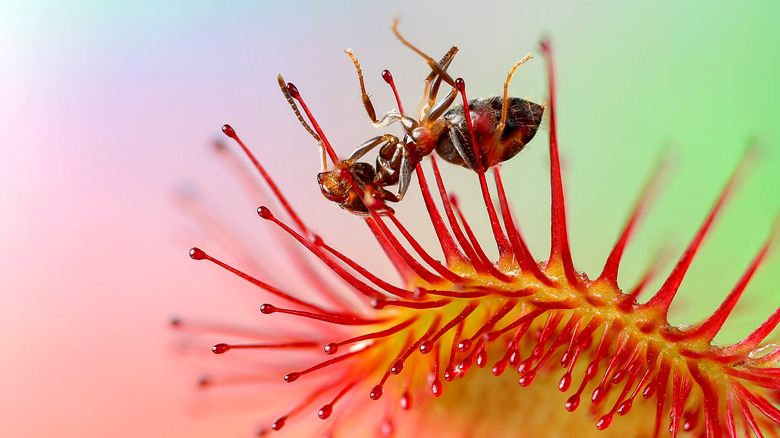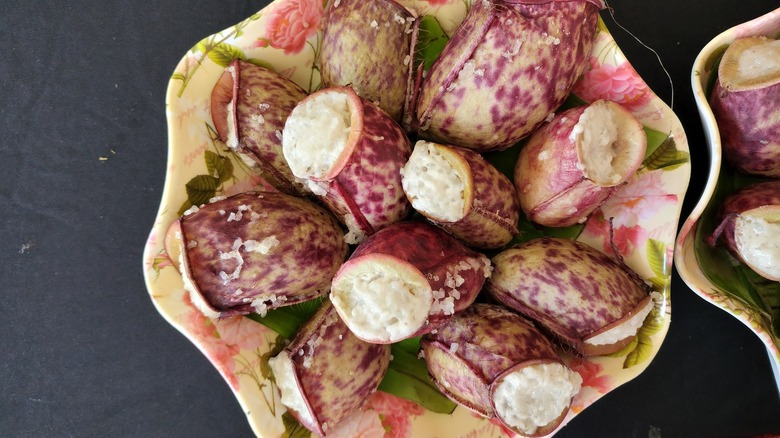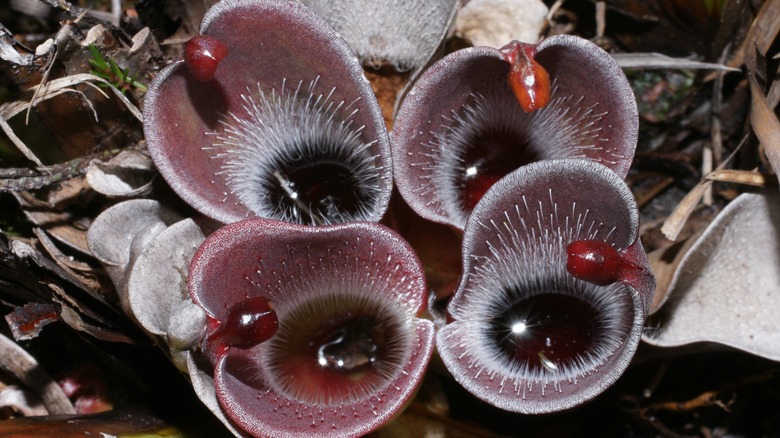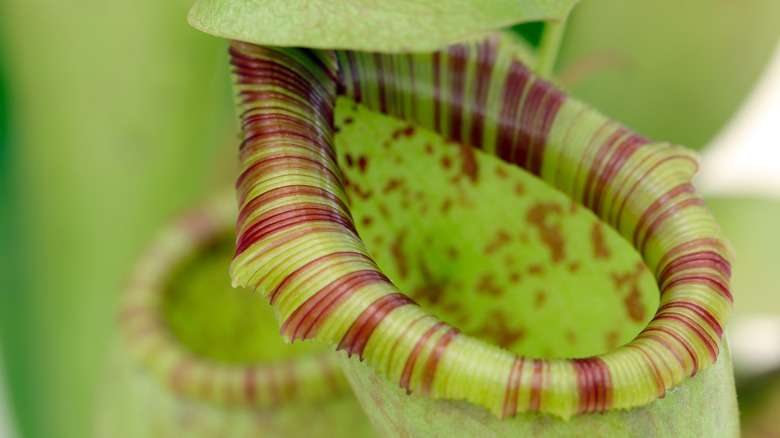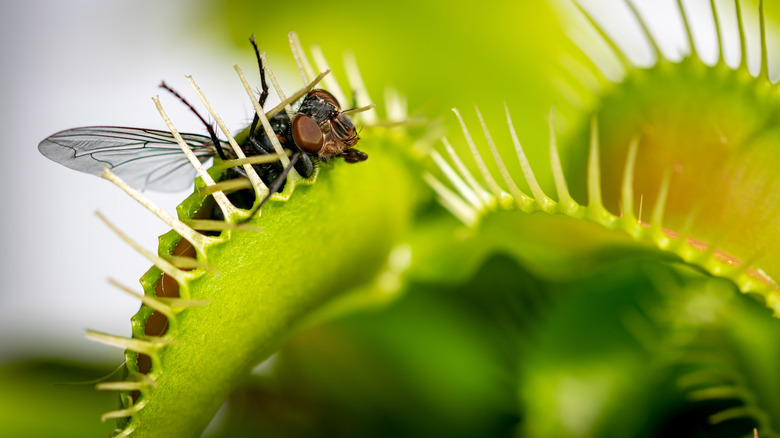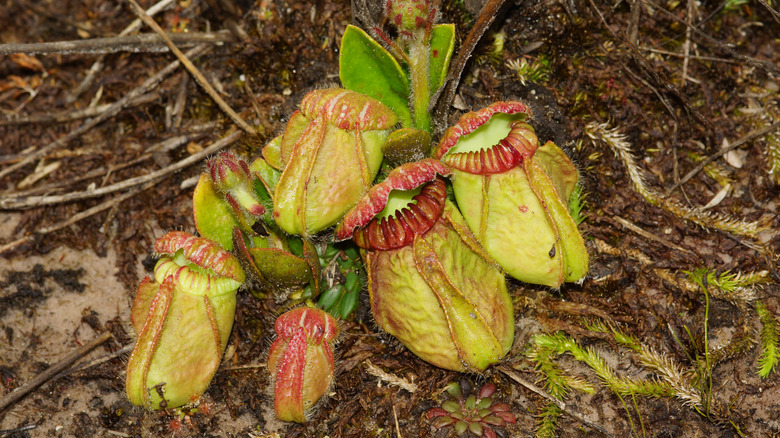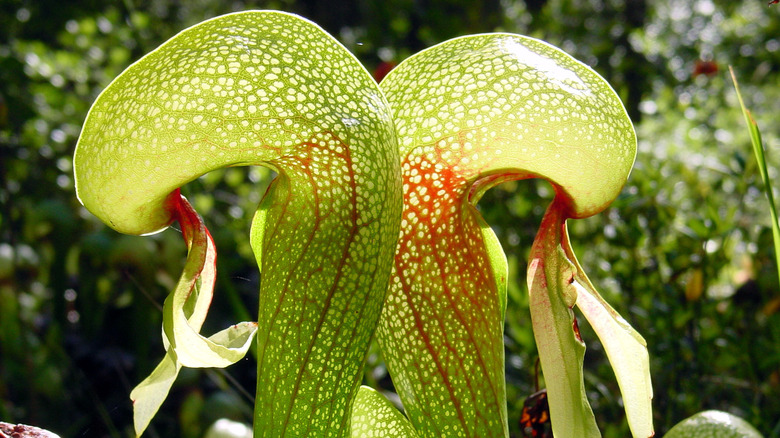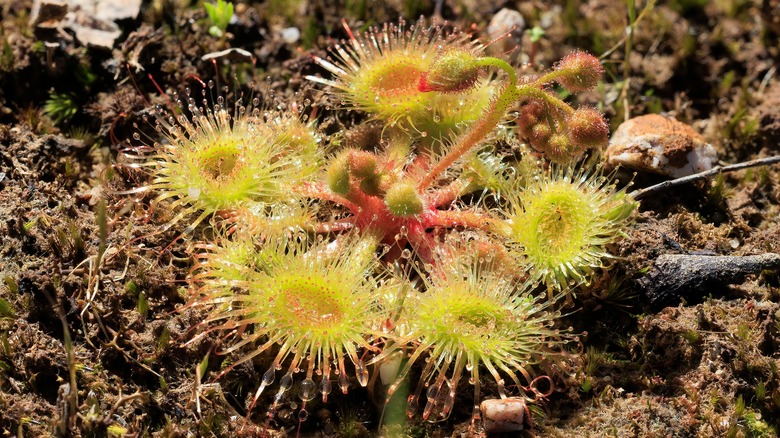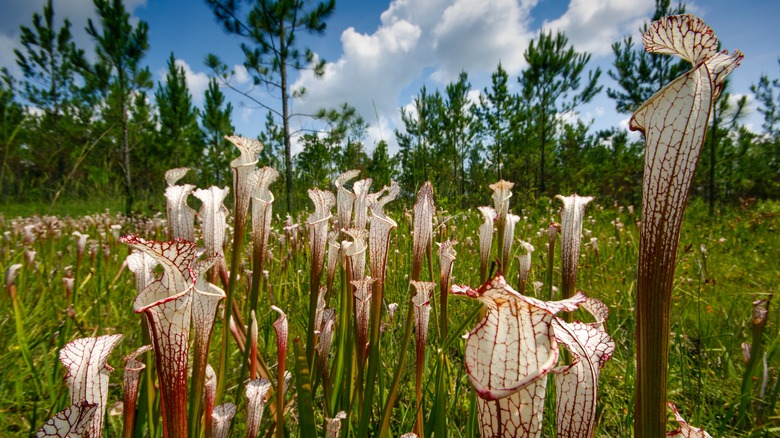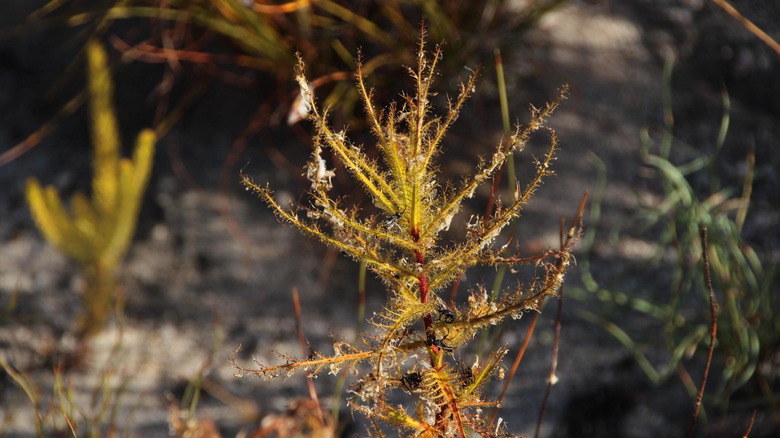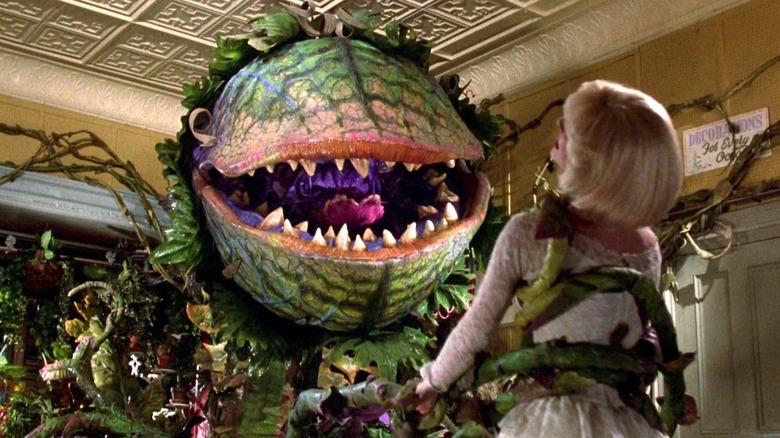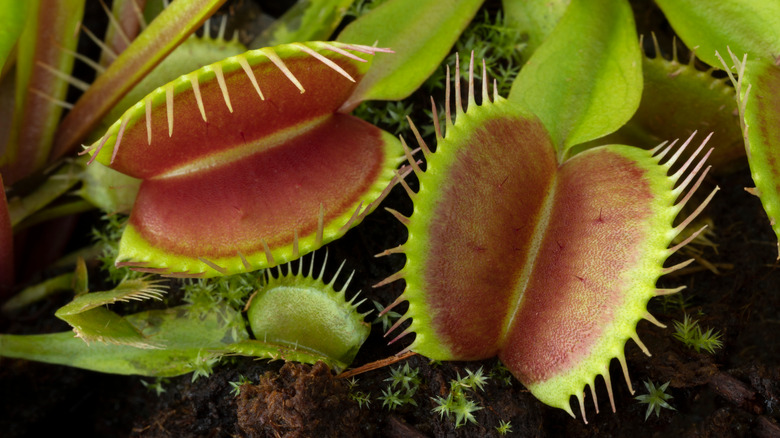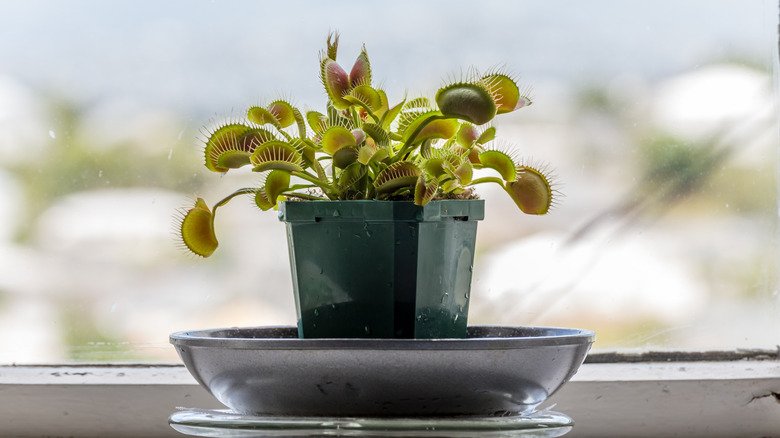Myths People Believe About Carnivorous Plants
There's something about carnivorous plants that just fascinates people. In a world full of animals eating plants, the idea of a handful of plants turning the tables and feasting on animals just feels oddly poetic. So much so that, for centuries, carnivorous plants have captivated scientists like Charles Darwin and authors like Arthur Conan Doyle alike. It's a surprisingly diverse group of plants too, with London's Natural History Museum noting about 630 known species of them in the world today, with new varieties still being discovered as recently as spring of 2023. Botanists have found that plants have separately evolved the ability to digest animals at least 12 times that we know of. Clearly, it's a winning strategy for the few plants that use it.
Killer plants have long been part of fiction, from the alien plant invaders in John Wyndham's "Day of the Triffids" with their poisonous stings, to the charismatic monster plant in the dark comedy musical "Little Shop of Horrors." As undeniably fun as it is to watch the bloodthirsty vegetable villain Audrey II begging "Feed me," the truth about real-world carnivorous plants doesn't quite match up with their depictions in stories. Myths and misconceptions abound with these curious little florae. Make no mistake, though — while they're unlikely to be devouring any sadistic dentists anytime soon, real carnivorous plants are still fascinating in their own ways.
Myth: Carnivorous plants are poisonous
It's a popular idea that carnivorous plants are poisonous. For one thing, they're often associated with fictional characters such as DC's Poison Ivy, with her toxic superpowers and fondness for letting killer plants take care of her enemies. The plant she's named after is a big reason why many people are wary of strange plants. Despite its name, though, poison ivy is not actually poisonous — but that doesn't stop it from giving a nasty blistering rash to anyone who accidentally touches it. While it's true that there are many poisonous plants in the world, and some of them are quite lethal, actual deaths from plant poisons are mercifully rare.
Carnivorous plants you're likely to encounter are not poisonous, either to people or pets. They may lure insects to their doom, but they don't use toxins to kill them. In fact, far from being poisonous, some are actually used in cooking. Per BBC Travel, carnivorous plants are part of the local cuisine in Borneo. On the streets of the Malaysian city of Kota Kinabalu, vendors sell a popular snack called lemang periuk kera (pictured), consisting of a pitcher plant trap stuffed with sticky coconut rice. Nepenthes pitcher plants mostly grow in the forests of the Malay Archipelago, finding their way into this Malay heritage food originally made by local Indigenous people. The plant pitchers are cleaned, filled with rice and coconut milk, then steamed. Traditionally, though, the plant itself isn't actually eaten. It's just a convenient biodegradable wrapper.
Myth: They come from tropical rainforests
Carnivorous plants seem quite exotic, so many people think they come from tropical rainforests, but this isn't always true. Some certainly are rainforest plants, like Nepenthes pitcher plants. These grow wild across Southeast Asia where they are indeed easy to find in rainforests. Many are so well adapted to forest life that they grow wild as epiphytes — plants that live harmlessly on the branches of trees. Far from the soil, where nutrients are scarce, their carnivorous lifestyle allows them to thrive, using the insects they catch to get the nutrition that their roots can never reach.
Carnivorous plants grow in a variety of habitats, though. As Nature explains, carnivory is how plants adapt to cope with nutrient-deficient environments, allowing them to get all the nitrogen and phosphorous they need from their prey. Many grow in wetlands, like Heliamphora pitcher plants from the cool mountain plateaus of South America (pictured). Venus flytraps, the most iconic of botanical carnivores, are only native to the swamps of North and South Carolina.
Farther afield, glistening sundews with their glue-covered bristles can be found in the cooler climates of Canada and Europe, where they like to grow in bogs too scarce in nutrients for most plants to survive. Not only do these carnivores prefer cold climates, they need a cold winter season to survive long-term. The northernmost carnivorous plant is a butterwort, with leaves like sticky flypaper. It's native to Svalbard, a Norwegian archipelago inside the Arctic Circle.
Myth: They need to eat like animals do
Carnivorous plants in fiction, like Morticia's pet plant Cleopatra in "The Addams Family," are often shown devouring food in much the same way an animal would. While real-life carnivorous plants certainly do catch and digest their prey, they don't actually eat in the same way that animals do. Nor do they need to. While animals need food for energy, carnivorous plants are still plants first and foremost, getting all the energy they need from photosynthesis. Catching light allows the plants to create and store sugars that animals can only acquire by eating. For a plant, catching and digesting prey serves only one purpose — fertilizer.
As any gardener will tell you, plants need three main nutrients: nitrogen, phosphorus, and potassium, usually abbreviated to NPK in commercially available fertilizers. While most plants gather these resources with their roots, carnivorous plants grow in places where they're too scarce to find enough of. Their insect diet allows them to flourish in places where other plants can't find enough nutrition to grow.
Because they don't rely on eating for energy, most carnivorous plants don't need to feed regularly. While catching prey gives them a nutrient boost and helps them to grow, most can survive on only a few meals every year. Some carnivores can even specialize, depending on where they live. Per Botany One, researchers have found that Nepenthes pitcher plants (shown above) that catch more insects will put more energy into growing new traps.
Myth: Flytraps can bite
Part of what makes a Venus flytrap look so interesting is the way its traps look a lot like tiny mouths, complete with teeth. This is likely the inspiration behind many fictional depictions of carnivorous plants, from "Little Shop of Horrors" to the iconic piranha plants in the "Super Mario Bros." games. While these fictional carnivores are shown with tooth-filled mouths, able to chomp, gnash, and even talk, their real-world counterparts are a lot more tame. Despite its appearance, a Venus flytrap doesn't actually bite. The fang-like bristles that line the traps act more like bars of a cage, preventing hapless insects from escaping before the trap fully closes.
If a Venus flytrap closes on your fingertip, it won't actually hurt. The traps snap closed very quickly, but they're incapable of exerting the kind of pressure they'd need to actually nip at you. In fact, Venus flytraps can't even bite the prey they're intended to catch. The plant will struggle with any prey that's larger than a third the size of its traps; anything bigger usually starts to rot before it can be fully digested. Being unable to bite, any prey that's too large will actually prevent a trap from closing properly. Often, this causes the trap to die, forcing the plant to grow a new one.
Myth: Pitcher plants smell bad
This one is understandable. There are many varieties of pitcher plants in the world, many of which grow in wetlands, from the tall Sarracenias of North America to the short, bristly Cephalotus found in southwestern Australia (pictured). While they may live in very different parts of the world, they all trap their prey in much the same way. Insects are lured into their traps, finding a watery grave where they drown and then slowly dissolve. Some people are put off by this, thinking that traps full of half-digested insects might smell bad.
The truth is that these plants don't smell much at all. Some people report that the nectar the plants produce to lure in their prey has a faintly minty aroma, but it's certainly not overpowering. Per Phys Org, some Nepenthes pitcher plants even produce floral scents, mimicking flowers as they try to entice insects into their traps. The only time these plants might start to smell is if they've been fed something they shouldn't be — no matter the temptation, never try and feed raw meat to a pitcher plant. Most will do just fine catching their own insects.
The myth of carnivorous plants smelling bad may come from other plants that use more offensive odors to attract insects. Some parasitic plants, for instance, produce flowers that smell like rotting meat, attracting carrion flies as pollinators. The carnivores, though, are much less discerning about the kind of insects they lure in.
Myth: The traps are flowers
In fiction, carnivorous plants are often shown trapping their prey inside flowers. The piranha plants from "Super Mario Bros." are probably the best example, with big toothy flower heads sitting atop their spindly little vines. The traps of many real-world carnivorous plants are certainly no less eye-catching than flowers, and some are even included in floral bouquets, particularly those with more striking appearances like the red and white Sarracenia leucophylla. But, despite their attractive appearances, these are not flowers.
The traps of carnivorous plants are nearly all highly specialized leaves, all surprisingly similar even in completely unrelated carnivorous plants. With some, like Nepenthes pitchers and Venus flytraps, the traps are a modified part of the leaf, while in sundews and Sarracenia pitchers, entire leaves are modified into traps. Plants don't have a digestive tract like animals, but a study in Plant Physiology explains that each of these leaves is actually its own all-in-one digestive system.
All the same, some carnivorous plants are misnamed as flowers. The California pitcher (Darlingtonia — shown above), from Northern California and Oregon, sometimes goes by the name of cobra lily for its distinctive hooded traps, resembling a snake rearing up. At the same time, carnivorous plants do still have flowers, though they're often much less showy than the traps. They also don't catch any prey. When insects are needed for pollination, it's best to let them leave without eating them.
[Featured image by NoahElhardt/Wikimedia Commons | Cropped and scaled | CC BY-SA 3.0]
Myth: All carnivorous plants move fast
Venus flytraps are famous for their rapid movement. While all plants move, it's usually so slow that it's impossible for us to notice in real-time. Plants that can move fast enough for us to see are extremely rare. Venus flytraps aren't the only carnivorous plants that can move quickly, though. They're not even the fastest. One type of Australian sundew, Drosera glanduligera (pictured), has snapping tentacles at the edges of its deadly leaves. As NBC reports, any insect that triggers them will be catapulted into the middle of the plant's deadly leaf in just 75 milliseconds. That's quite literally faster than the blink of an eye! Even this isn't the fastest, though. The carnivorous plant speed record belongs to a plant called the bladderwort (Utricularia), with tiny underwater traps that vacuum up their prey in less than a millisecond.
Many carnivorous plants don't actually move at all, preferring to catch their prey with passive traps. Often, they use pitfall traps, like Sarracenia or Cephalotus. Another common method is to use sticky leaves that catch insects like flypaper, like with the butterwort (Pinguicula) plants. These passive carnivores may not move, but some of them are still opportunists. Per the University of Bristol, some Nepenthes pitcher plants have evolved a trick to get their motion without expending their own energy, using falling raindrops to help them flick insects into their traps.
Myth: They only eat insects
Many people familiar with carnivorous plants might think they only catch insects, and it's true that insects and spiders are the main prey for most of these plants. For many, it's probably more accurate to call them insectivorous plants. The sticky leaves of a butterwort, for example, aren't able to catch anything larger than a fly. If you think all carnivorous plants only catch bugs, though, you may be in for a surprise.
Per National Geographic, pitcher plants catch enough vertebrate animals that even the scientists studying them were surprised. This isn't restricted to the big pitcher plants growing in tropical climates, either. Botanists discovered these greedy little plants growing in Canada. Reportedly, they often catch salamanders, giving them a huge boost in nutrients. With many carnivorous plants growing in wetlands, amphibians can often find themselves on the menu, and even the Venus flytrap can catch more than just flies. If their traps are large enough, they'll happily snap shut on small frogs.
Elsewhere, carnivorous plants are known to catch even larger animals in their traps. The most notorious are the tropical Nepenthes pitchers, with their larger traps. As BBC News reports, these have been known to trap garden songbirds, and the world's largest pitcher plant, Nepenthes attenboroughii, is large enough to catch rats.
Myth: Prehistoric carnivorous plants were giant
Ancient Earth lives in our imaginations as a time of giants, like woolly mammoths and tyrannosaurs, so it's not hard to imagine ancient carnivorous plants being similarly huge. The trope shows up from time to time in stories, like the 1970 movie "When Dinosaurs Ruled the World." While it's certainly true that carnivorous plants existed back when Earth was still home to dinosaurs, the rest is fiction.
One ancient carnivorous plant fossil was found trapped in amber. Per New Scientist, this plant grew roughly 40 million years ago and is probably an ancestor of a modern carnivorous plant called a Roridula (pictured) — a small shrub that catches insects in a similar way to sundews. Another, even older carnivorous plant fossil has also been found, in a rock formation 124 million years old. Reported in the journal Acta Botanica Gallica, this was a pitcher plant that most definitely shared the Earth with dinosaurs, but it was only a couple of inches tall.
The biggest carnivorous plants known are actually alive and well today. The world's largest pitcher plants are big enough that their traps can carry as much as three quarts of liquid each. Of course, there's always a possibility that truly giant carnivorous plants may still have existed at some point during Earth's history. If they did, though, no fossils have ever been found to prove it. Yet.
[Featured image by Tony Rebelo/iNaturalist | Cropped and scaled | CC BY-SA 4.0]
Myth: They can eat people
The idea of murderous plants has been in our imaginations for a long time. It was a popular trope in fiction during Victorian times, with some stories written as first-hand accounts so convincingly that, to many people, it wasn't entirely clear whether or not these tales were true. Among the most famous works of killer plant fiction was a short story by Arthur Conan Doyle, "The American's Tale," about a man seemingly killed by a giant flytrap plant. The trope of the killer plant never quite went away, with the 20th-century story "Green Thoughts" by John Collier reputedly being the inspiration behind "Little Shop of Horrors" (pictured).
Of course, these are just stories. Real carnivorous plants have no way to actually harm a human, and aren't large enough to do so, even if they could. Theoretically, it's not impossible for pitcher plants to digest people, if they were big enough. Per Atlas Obscura, though, it would take a long time, and would probably give the plant indigestion.
There are some plants out there with a reputation for killing larger prey, though. A bromeliad, Puya chilensis, has a reputation for killing animals such as sheep. It isn't really a carnivorous plant because it doesn't do any digesting, but it does ensnare animals with thick fur until they starve to death. Once they decay, the plant's roots feast on the nutrients they leave behind.
Myth: Carnivorous plants are sentient
The question of whether or not plants are conscious is not as straightforward as it may appear. Whatever the answer, most botanists will agree that even if they don't have the kind of awareness that animals do, plants still have a set of senses that they use to perceive and interact with the world around them. The carnivorous plants in media, though, aren't usually very plant-like. Whether it's the enormous kaiju-eating plant monster from the 1989 movie "Godzilla vs. Biollante" or the tiny bellsprout from "Pokémon," fictional carnivorous plants tend to behave much more like animals than plants.
This leads some people to seriously wonder, are some carnivorous plants sentient? After all, a Venus flytrap is able to sense the prey in its traps and respond to it too. Unfortunately, there's no evidence that they can think, feel, and react in the same way animals do, but that doesn't make Venus flytraps any less interesting. Unlike an animal, a plant has no nervous system. All the same, per ZME Science, Venus flytraps do have a set of senses all of their own. Their traps are triggered by sensory hairs that respond to touch, but they're also cleverly adapted to only close under the right conditions, so the plant avoids wasting energy using its traps for no reason. To help tell the difference between prey and something like raindrops, Venus flytraps even have a kind of short-term memory.
Myth: They make good houseplants
Carnivorous plants are such interesting little things that they're among the most popular cultivated plants in the world. If you've ever visited a garden center or plant nursery, you've almost certainly seen a few on sale. They're often sold as houseplants and sometimes intended for children. Botanophiles should be warned, though, that keeping carnivorous plants is more difficult than most people realize.
As the New York Botanical Garden explains, there are a few different kinds of carnivorous plants you may encounter sold as houseplants, and some have very specific requirements. Many struggle indoors because they don't get enough light to grow healthily. They also enjoy humidity and have some very specific water requirements. Tap water and bottled water usually contain too many dissolved minerals for these plants to handle, and these can harm or even kill them. These are surprisingly sensitive plants, and ideally need rainwater or distilled water to thrive.
Of course, this isn't to say that you shouldn't try growing carnivores at home. If you do, though, keep in mind that they're a little more like pets than other houseplants — before you take one home, make sure you know how to care for it properly. Venus flytraps can live for up to 20 years in the wild so, much like keeping an animal, a carnivorous plant is for life.
